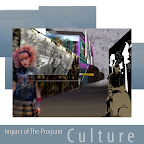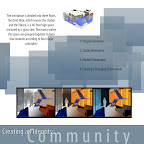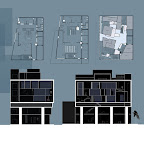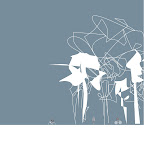
Other speakers included John Duke, the Clinic Director of Outside/In, a social service for homeless youth in Portland, Abby Dacey of AWB-Oregon and Janet Hammer, Director of PSU’s Social Equity and Opportunity Forum. Each speaker presented his/her organization's work, followed by a question and answer session with the 50 or so people who were in attendance.
There were many issues touched upon by the panel, but I came away from the discussion thinking about a few things in particular. First, there was this issue of architecture as an active rather than a passive profession. Traditionally the architecture process is controlled by the client. Bell spoke about the necessity of architects and urban planners to take the initiative and present clients with solutions to problems they are not aware of, problems that clients have neither the resources nor the qualifications to consider. Clients cannot always see the negative (or positive) ramifications of their actions on the surrounding environment. The urban implications of a new project in the built environment and the sociocultural opportunities within that project are complex and difficult to recognize. Many clients involved in a building project are restricted to focus on their personal goals or the security of their employees and they cannot assume responsibility to focus on the larger implications of their physical presence or the potential of that presence to improve upon existing conditions. This is a void in the design process that is slowly being filled by an emerging generation of professionals. It is not necessarily a new idea as it is at the heart of good urban design, but it is one that is gaining popularity amongst individuals of all disciplines because of the expanding urge to fix the social injustices that are overwhelmingly apparent. If architects can take an active approach in design, they can more effectively communicate the larger picture to their clients and help bridge the gap between client and the urban environment.
Another point that Bell brought up dealt with the evaluation of successful design. Mentioning the negative effects of a value-based approach like LEED, Bell advocated a tripartite system he has dubbed SEED. It stands for Social Environmental Economic Design. He is currently working on making a comprehensive checklist/spreadsheet applicable during and after a project which can help measure those three factors which have largely been ignored as quantifiable data.
John Duke spoke about community involvement through art and architecture. Abby Dacey spoke about the 1% Agreement which business owners can sign to require their employees 20 hours of community service per year. Sergio Palleroni spoke briefly about Reflective practitioners, U.S. introspection, and Cultural Sustainability. Janet Hammer spoke about the social bottom line, community discussion and Market Creek which offered material ownership of developed land in the community (below is a picture of their Sempra Children's Art Wall).

This talk was inspirational to say the least. Often during the term it is easy to lose the connection between what I am doing at a specific moment and what I came here to do. Much of the work we do is so detailed and focused on specific projects that it is hard to see the bigger picture. It is refreshing to be reminded every once in a while about the impact that architecture can have on a community. There are people out there, a lot of people, who are frustrated with the current situation of our urban surroundings and who are working together to help improve them. In the end the overriding theme of this discussion was interdisciplinary collaboration. When it comes to making progress, everyone has something to offer. If we are going to achieve sustainability in the urban context - social, economic and environmental - we need to work with each other. More often than not this seems like a daunting task but there are moments in between the intimidation that inspire us. Granted I have been seeking these moments but they seem to be occurring with more frequency all the same. Maybe more importantly they seem to be more substantial, involving more people than ever before. What's even more captivating is that everyone appears to be working on essentially the same thing and it extends way beyond architecture.















